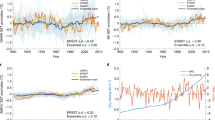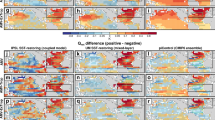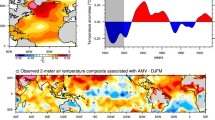Abstract
The Atlantic multidecadal variability (AMV) is a basin-scale mode of sea surface temperature (SST) variability in the North Atlantic, exerting a global impact, including contribution to the multidecadal Sahel drought and subsequent recovery and the post-1998 global warming hiatus. How greenhouse warming affects AMV remains unclear. Here, using models with multicentury-long outputs of future climate, we find an intensified AMV under greenhouse warming. Surface warming and freshwater input from sea-ice melt increase surface buoyancy, leading to a slowdown of the Atlantic meridional overturning circulation (AMOC). Reduced vertical mixing associated with suppressed oceanic deep convection results in a thinned mixed layer and its variability, favouring stronger AMV SST variability. Further, a weakened AMOC and the associated northward heat transport prolong the lifespan of the AMV, providing a long time for the AMV to grow. Thus, multidecadal global surface fluctuations and the associated climate extremes are likely to be more intense.
This is a preview of subscription content, access via your institution
Access options
Access Nature and 54 other Nature Portfolio journals
Get Nature+, our best-value online-access subscription
$32.99 / 30 days
cancel any time
Subscribe to this journal
Receive 12 print issues and online access
$259.00 per year
only $21.58 per issue
Buy this article
- Purchase on SpringerLink
- Instant access to full article PDF
Prices may be subject to local taxes which are calculated during checkout





Similar content being viewed by others
Data availability
Data related to the paper can be downloaded from the following: HadISST v.1.1, https://www.metoffice.gov.uk/hadobs/hadisst/; ERSST v.5, https://www.ncei.noaa.gov/products/extended-reconstructed-sst; and CMIP6 database, https://aims2.llnl.gov/search/cmip6/.
Code availability
The code for climate model data processing and analyses is available via Zenodo at https://doi.org/10.5281/zenodo.14286522 (ref. 45).
References
Kerr, R. A. A North Atlantic climate pacemaker for the centuries. Science 288, 1984–1985 (2000).
Zhang, R. et al. A review of the role of the Atlantic meridional overturning circulation in Atlantic multidecadal variability and associated climate impacts. Rev. Geophy. 57, 316–375 (2019).
Bjerknes, J. Atlantic air–sea interaction. Adv. Geophys. 10, 1–82 (1964).
Folland, C. K., Palmer, T. N. & Parker, D. E. Sahel rainfall and worldwide sea temperatures, 1901–85. Nature 320, 602–607 (1986).
Knight, J. R., Folland, C. K. & Scaife, A. A. Climate impacts of the Atlantic Multidecadal Oscillation. Geophys. Res. Lett. 33, L17706 (2006).
Latif, M., Keenlyside, N. & Bader, J. Tropical sea surface temperature, vertical wind shear, and hurricane development. Geophys. Res. Lett. 34, L01710 (2007).
Goldenberg, S. B., Landsea, C. W., Mestas‐Nuñez, A. M. & Gray, W. M. The recent increase in Atlantic hurricane activity: causes and implications. Science 293, 474–479 (2001).
Zhang, R. & Delworth, T. L. Impact of the Atlantic multidecadal oscillation on North Pacific climate variability. Geophys. Res. Lett. 34, L23708 (2007).
Sun, C. et al. Western tropical Pacific multidecadal variability forced by the Atlantic multidecadal oscillation. Nat. Commun. 8, 15998 (2017).
Kosaka, Y. & Xie, S.-P. Recent global-warming hiatus tied to equatorial Pacific surface cooling. Nature 501, 403–407 (2013).
Meehl, G. A., Arblaster, J. M., Fasullo, J. T., Hu, A. & Trenberth, K. E. Model-based evidence of deep-ocean heat uptake during surface-temperature hiatus periods. Nat. Clim. Change 1, 360–364 (2011).
Qasmi, S., Sanchez-Gomez, E., Ruprich-Robert, Y., Boé, J. & Cassou, C. Modulation of the occurrence of heatwaves over the Euro-Mediterranean region by the intensity of the Atlantic multidecadal variability. J. Clim. 34, 1099–1114 (2021).
Lee, S. K. & Wang, C. Delayed advective oscillation of the Atlantic thermohaline circulation. J. Clim. 23, 1254–1261 (2010).
Zhang, L. & Wang, C. Multidecadal North Atlantic sea surface temperature and Atlantic meridional overturning circulation variability in CMIP5 historical simulations. J. Geophys. Res. Oceans 118, 5772–5791 (2013).
Hand, R., Bader, J., Matei, D., Ghosh, R. & Jungclaus, J. H. Changes of decadal SST variations in the subpolar North Atlantic under strong CO2 forcing as an indicator for the ocean circulation’s contribution to Atlantic multidecadal variability. J. Clim. 33, 3213–3228 (2020).
Msadek, R., Frankignoul, C. & Li, L. Z. Mechanisms of the atmospheric response to North Atlantic multidecadal variability: a model study. Clim. Dynam. 36, 1255–1276 (2011).
Frankignoul, C., Gastineau, G. & Kwon, Y. O. Wintertime atmospheric response to North Atlantic ocean circulation variability in a climate model. J. Clim. 28, 7659–7677 (2015).
Wills, R. C., Armour, K. C., Battisti, D. S. & Hartmann, D. L. Ocean–atmosphere dynamical coupling fundamental to the Atlantic multidecadal oscillation. J. Clim. 32, 251–272 (2019).
Delworth, T. L. et al. The central role of ocean dynamics in connecting the North Atlantic oscillation to the extratropical component of the Atlantic multidecadal oscillation. J. Clim. 30, 3789–3805 (2017).
He, C. et al. Tropical Atlantic multidecadal variability is dominated by external forcing. Nature 622, 521–527 (2023).
Booth, B. B., Dunstone, N. J., Halloran, P. R., Andrews, T. & Bellouin, N. Aerosols implicated as a prime driver of twentieth-century North Atlantic climate variability. Nature 484, 228–232 (2012).
Vecchi, G. A., Delworth, T. L. & Booth, B. Origins of Atlantic decadal swings. Nature 548, 284–285 (2017).
Zhang, R. et al. Have aerosols caused the observed Atlantic multidecadal variability? J. Atmos. Sci. 70, 1135–1144 (2013).
Qin, M., Dai, A. & Hua, W. Influence of anthropogenic warming on the Atlantic multidecadal variability and its impact on global climate in the twenty-first century in the MPI-GE simulations. J. Clim. 35, 2805–2821 (2022).
Wu, S. & Liu, Z. Y. Decadal variability in the North Pacific and North Atlantic under global warming: the weakening response and its mechanism. J. Clim. 33, 9181–9193 (2020).
Taylor, K. E., Ronald, J. S. & Meehl, G. A. An overview of CMIP5 and the experiment design. Bull. Am. Meteorol. Soc. 93, 485–498 (2012).
Eyring, V. et al. Overview of the coupled model intercomparison project phase 6 (CMIP6) experimental design and organization. Geosci. Model Dev. 9, 1937–1958 (2016).
Liu, W., Fedorov, A. & Sévellec, F. The mechanisms of the Atlantic meridional overturning circulation slowdown induced by Arctic sea ice decline. J. Clim. 32, 977–996 (2019).
Meehl, G. A. et al. Context for interpreting equilibrium climate sensitivity and transient climate response from the CMIP6 Earth system models. Sci. Adv. 6, eaba1981 (2020).
Yamamoto, A., Tatebe, H. & Nonaka, M. On the emergence of the Atlantic multidecadal SST signal: a key role of the mixed layer depth variability driven by North Atlantic oscillation. J. Clim. 33, 3511–3531 (2020).
Deng, J. & Dai, A. Sea ice–air interactions amplify multidecadal variability in the North Atlantic and Arctic region. Nat. Commun. 13, 2100 (2022).
Gregory, J. M. et al. A model intercomparison of changes in the Atlantic thermohaline circulation in response to increasing atmospheric CO2 concentration. Geophys. Res. Lett. 32, L12703 (2005).
Liu, W., Xie, S. P., Liu, Z. & Zhu, J. Overlooked possibility of a collapsed Atlantic meridional overturning circulation in warming climate. Sci. Adv. 3, e1601666 (2017).
Jahn, A. & Holland, M. M. Implications of Arctic sea ice changes for North Atlantic deep convection and the meridional overturning circulation in CCSM4‐CMIP5 simulations. Geophys. Res. Lett. 40, 1206–1211 (2013).
Bakker, P. et al. Fate of the Atlantic meridional overturning circulation: strong decline under continued warming and Greenland melting. Geophys. Res. Lett. 43, 12252–12260 (2016).
Mecking, J. V. & Drijfhout, S. S. The decrease in ocean heat transport in response to global warming. Nat. Clim. Change 13, 1229–1236 (2023).
Rayner, N. A. et al. Global analyses of sea surface temperature, sea ice, and night marine air temperature since the late nineteenth century. J. Geophys. Res. 108, 4407 (2003).
Huang, B. et al. Extended reconstructed sea surface temperature version 5 (ERSSTv5), upgrades, validations, and intercomparisons. J. Clim. 30, 8179–8205 (2017).
Frankignoul, C., Gastineau, G. & Kwon, Y. O. Estimation of the SST response to anthropogenic and external forcing and its impact on the Atlantic multidecadal oscillation and the Pacific decadal oscillation. J. Clim. 30, 9871–9895 (2017).
Ting, M., Kushnir, Y., Seager, R. & Li, C. Forced and internal twentieth-century SST trends in the North Atlantic. J. Clim. 22, 1469–1481 (2009).
Deser, C. & Phillips, A. S. Defining the internal component of Atlantic multidecadal variability in a changing climate. Geophys. Res. Lett. 48, e2021GL095023 (2021).
Wu, Z. & Huang, N. E. Ensemble empirical mode decomposition: a noise-assisted data analysis method. Adv. Adapt. Data Anal. 1, 1–41 (2009).
Jackson, L. C. et al. The evolution of the North Atlantic meridional overturning circulation since 1980. Nat. Rev. Earth Environ. 3, 241–254 (2022).
Bartlett, M. S. Some aspects of the time-correlation problem in regard to tests of significance. J. R. Stat. Soc. 98, 536–543 (1935).
Wang, Y. Codes for “Intensified Atlantic multidecadal variability in a warming climate”. Zenodo https://doi.org/10.5281/zenodo.14286522 (2024).
Acknowledgements
S.L. is supported by the National Natural Science Foundation of China (NSFC) projects (42376198 and 92058203), the Science and Technology Innovation Project of Laoshan Laboratory (LSKJ202202602) and the Youth Talent Programme of Ocean University of China. T.G. is supported by Taishan Scholars Program. B.G. is supported by the National Key Research and Development Program of China (2023YFF0805103). Y.Y. is supported by the NSFC project (42322601) and the National Key Research and Development Program of China (2023YFF0805100). We acknowledge the WCRP Working Group on Coupled Modelling, which is responsible for CMIP, and we thank the climate modelling groups for producing and making available their model output.
Author information
Authors and Affiliations
Contributions
S.L. and L.W. conceived the study and wrote the initial manuscript in discussion with W.C. and T.G. S.L. and Y.W. performed model analysis and generated final figures. S.L., L.W., W.C., T.G., B.G., Z.J. and Y.Y. contributed to interpreting results, discussion of the associated dynamics and improvement of this paper.
Corresponding author
Ethics declarations
Competing interests
The authors declare no competing interests.
Peer review
Peer review information
Nature Climate Change thanks the anonymous reviewers for their contribution to the peer review of this work.
Additional information
Publisher’s note Springer Nature remains neutral with regard to jurisdictional claims in published maps and institutional affiliations.
Extended data
Extended Data Fig. 1 Characteristics of AMV in observations and CMIP6 historical simulations.
a, Observed SST pattern associated with AMV (unit: °C), which is derived from regressing SST anomalies onto the observed AMV index during the period of 1870-2014. Shown is the mean result of two reanalysis datasets (that is HadISST v1.1 and ERSST.v5). b, Same as a, but for the multimodel ensemble mean result of the CMIP6 historical outputs. c, Time evolution of the AMV indices in observations (black line for HadISST v1.1 and grey line for ERSST.v5) and CMIP6 multimodels (colored lines). The AMV index is biquadratically detrended and filtered by 21-yr running mean. Models reasonably simulate the observed AMV.
Extended Data Fig. 2 Life cycle of the AMV and associated fields in CMIP6 models under PiControl scenario.
The regression patterns of a, SST (shading; unit: °C) and net surface heat flux (Qnet, contours; unit: W/m2; positive in red and negative in blue; positive downward into the ocean), b, mixed layer depth (MLD; unit: m), c, Atlantic meridional overturning stream function (AMOC; unit: Sv) and d, boreal winter sea ice concentration (SIC; unit: %) anomalies onto the normalized AMV index at different lags in CMIP6 PiControl simulations. Shown are the multimodel ensemble mean results. The AMV is predominantly sustained by the AMOC related oceanic heat transport, while the Qnet plays a damping role.
Extended Data Fig. 3 Spectral analysis of unfiltered AMV index in PiControl and under SSP585 (or RCP85) scenario in CMIP6 (or CMIP5) models.
The power spectrum in PiControl experiments is signified by blue solid line, and the power spectrum under a SSP585 or RCP85 scenario is signified by red solid line. The 90% confidence level is signified by dashed line based on a red noise null hypothesis. The upper (lower) panel show the 7 models from CMIP6 (CMIP5) dataset. The AMV in most models shows increased multidecadal variability and a prolonged periodicity under global warming.
Extended Data Fig. 4 The climatological mean of the mixed layer depth (MLD), net surface heat flux (Qnet) and boreal wintertime sea ice concentration (SIC).
a, The climatological pattern of the annual mean MLD under the PiControl, SSP126 and SSP585 scenario. Unit is m. Shown is the multimodel ensemble mean result. b, Same as a, but for the Qnet. Unit is W/m2. Positive values denote heat downward into the ocean. c, Same as a, but for the boreal wintertime (DJF) Arctic sea ice concentration. Unit is percentage (%). Projected shallowed MLD in the subpolar North Atlantic is key to increased AMV under global warming, despite damping from the Qnet, and melt of Arctic sea ice.
Extended Data Fig. 5 Grid-point standard deviation in the MLD decadal variability in PiControl and SSP585 scenarios.
a, Decadal variability of MLD at each grid point is derived by removing the biquardratic trend and smoothed by 21-year running mean. Unit is m. Shown is the MMEM result. b, Same as a, but for the SSP585 scenario. Models simulate decreased MLD decadal variability in a warming climate.
Extended Data Fig. 6 Atlantic meridional ocean heat transport (OHT) on average under PiControl, SSP126 and SSP585 scenario.
a, The OHT under PiControl scenario. Unit is PW (1 PW = 1015 W). b, Same as a, but for the SSP126 scenario. c, Same as a, but for the SSP585 scenario. The Atlantic OHT is northward in both hemispheres and across the equator due to the AMOC, with a maximum OHT value located around 20°N. The OHT decreases in response to global warming.
Extended Data Fig. 7 An accumulative effect of the prolonged advection for the intensified AMV.
a, Inter-model relationship between the standard deviation changes in Atlantic OHT variability (unit: W) at 46°N and change in the AMV. Both are scaled by the climate sensitivity in respective model. Correlation coefficient and P value are also indicated based on a two-tailed Student’s t-test. b, Inter-model relationship between changes in the standard deviation of the time integral of the Atlantic OHT (unit: W) at 46°N and changes in the AMV. Both are scaled by the climate sensitivity in respective model. Correlation coefficient and P value are also indicated based on a two-tailed Student’s t-test. A greater increase in variability of the time integral of Atlantic OHT favors an increase in variability of the AMV.
Extended Data Fig. 8 Example of OHT decadal variability and the integral of OHT in each phase.
We take the MRI-ESM2-0 model as an example. To consider the effect of meridional advection time length in each AMV cycle, we integrate the OHT over the time of a positive or of a negative phase, respectively. The approach yields a new index of the integral of each phase.
Extended Data Fig. 9 Oceanic heat budget analysis based on the CMIP6 PiControl simulations for the upper 500 m ocean in the subpolar North Atlantic.
Terms shown are the seven models averaged regression coefficients of eight controlling factors onto the temperature tendency terms (\(\frac{\partial T{\prime} }{\partial t}\)) to estimate individual contributions based on Eq. (1). \(\bar{U}\frac{\partial }{\partial x}{T}^{{\prime} }\) and \({u}^{{\prime} }\frac{\partial }{\partial x}\bar{T}\) denote the temperature anomalies carried by the mean and anomalous zonal advection; \(\bar{V}\frac{\partial }{\partial y}{T}^{{\prime} }\) and \({v}^{{\prime} }\frac{\partial }{\partial y}\bar{T}\) denote the temperature anomalies carried by the mean and anomalous meridional advection; \(\bar{W}\frac{\partial }{\partial z}{T}^{{\prime} }\) and \({w}^{{\prime} }\frac{\partial }{\partial z}\bar{T}\) denote the temperature anomalies carried by the mean and anomalous vertical advection; \(\frac{{Q}^{{\prime} }}{{\rho }_{0}{C}_{P}H}\) is atmospheric heating/cooling from net heat flux (positive downward), in which \({\rho }_{0}\) is the density of seawater taken as 1025 kg m−3, \({C}_{P}\) the heat capacity of seawater taken as 4200 J kg−1 K−1, and H the ocean upper layer depth taken as 500 m; and Res is residual which includes mixing and diffusive terms. Error bar of each term shows one standard deviation value of 7 models in PiControl experiment. Temperature tendency is largely balanced between heat input from mean meridional heat advection and damping by air-sea net heat flux.
Extended Data Fig. 10 Changes in the AMV-related Q’ under global warming.
We show the changes in the regression patterns of Qnet anomalies onto the normalized AMV index between PiControl and SSP585, with an area-averaged increase of 0.43 W/m2. Shown is the MMEM result. AMV-related Q’ is projected to increase under global warming.
Supplementary information
Supplementary Information
Supplementary Tables 1 and 2 and Figs. 1–4.
Rights and permissions
Springer Nature or its licensor (e.g. a society or other partner) holds exclusive rights to this article under a publishing agreement with the author(s) or other rightsholder(s); author self-archiving of the accepted manuscript version of this article is solely governed by the terms of such publishing agreement and applicable law.
About this article
Cite this article
Li, S., Wu, L., Wang, Y. et al. Intensified Atlantic multidecadal variability in a warming climate. Nat. Clim. Chang. 15, 293–300 (2025). https://doi.org/10.1038/s41558-025-02252-x
Received:
Accepted:
Published:
Issue date:
DOI: https://doi.org/10.1038/s41558-025-02252-x
This article is cited by
-
Analysis of the factors promoting urban green productivity using a system dynamics simulation
Scientific Reports (2025)
-
Climate impacts of the El Niño–Southern Oscillation in Africa
Nature Reviews Earth & Environment (2025)



